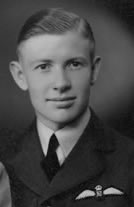D-Day
D-Day memories, Maurice Mayston

Maurice Mayston in 1943 – before leaving New Zealand
Maurice Mayston was a fighter pilot with 485 NZ Spitfire Squadron. On D-Day his squadron shot down the first German bomber over the Normandy battlefield – and quickly followed it with a second. From then until August 1945 Maurice was on continuous active service, based in France, Belgium, Holland and Germany.
Normandy coast from the air
Maurice Mayston describes flying from England towards the Normandy coast on the morning of D-Day.
![]() Hear
this sound file (mp3, 249k)
Hear
this sound file (mp3, 249k)
Transcript
'We went out in the first light, before the dawn. We were lucky, although there was other cloud the East still had this glow and we could see down below the darkness of the land and the shiny surface of the sea and the light was getting better every minute of course, and then dawn broke, and we saw this immense armada of ships in the semidarkness. It was awesome and there were the hundreds and hundreds of landing craft, loaded up with men heading towards the beaches all in nice neat lines and order. It was awesome, there's no other word really. And something that we'd been looking for and here it was happening. It was absolutely wonderful.'

New Zealand spitfire pilot, Flight Lieutenant Maurice Mayston, RAF, 2nd from right, back from a fighter sweep over France in the days before D-Day.
485 Squadron in action
Here Maurice describes the skies over Normandy on the afternoon of D-Day – and the shooting down of the German bombers. The leader of his squadron and the pilot of the plane to shoot down the first German bomber of the battle was fellow Kiwi, Flight Lieutenant Johnnie Houlton.
![]() Hear
this sound file (mp3, 662k)
Hear
this sound file (mp3, 662k)
Transcript
'Our orders were to patrol down the beachhead – well there were about a thousand Spitfires up there over the line of beaches that were being attacked and landed on. It was like a feeding frenzy almost, and enemy aircraft would poke its nose out of the cloud and you'd hear on the radio, "I've got him, I've got him. No, no, no I've got him", and [it was] the first one there to get another score.
So you'd just swarm towards the bomber?
Yeah, that's right, and to Johnnie [Houlton] and the rest of us this was not on. So he decided that he would patrol back of the beaches, behind in the hinterland more.
So tell me how you came to make the hit that you did make that day.
Johnnie was the leader and we patrolled behind the beaches at the back and sure enough he's got very keen eyes, he spotted a Junkers 88 scooting along flat out.
He just announced Duncan Blue, Bandit, 2 o'clock, Angels 4 I think it was – that was all he'd need to say – and we knew exactly straight away and he lead us down to this aircraft. He chased after it. My job was to cover his back, I'm his number two, that's what I'm there for – I've got to make sure he's able to do his job which is to shoot down the aircraft.
Can you describe what it was like, what you felt like when you came in and got that aircraft?
We were doing what we'd been training for for months – for years almost. We were just doing what we'd dreamed of. It was all over in seconds of course – about 2 minutes later we saw a second aircraft doing exactly the same thing and that time again he attacked it, knocked out the starboard engine, and then he ordered myself number two, and Blue Three and Blue Four to have a go. And so we shared that second aircraft, a quarter each. And that's my score for the war.'

Maurice Mayston, 2004.
Black and white images on this page are from the Maurice Mayston collection.
Next: O'Brian Reeve >